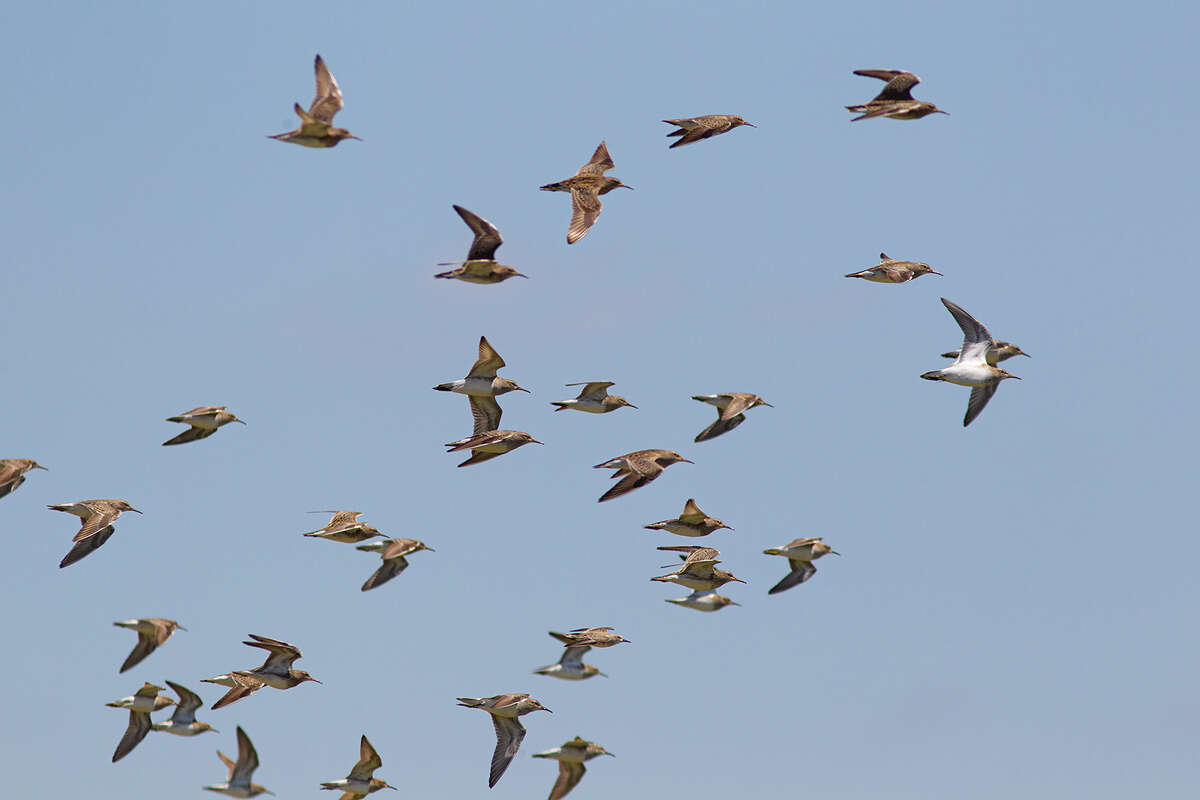Migratory shorebirds have stamina to fly as far as 10,000 miles on their journey north
Gary Clark, Correspondent
April 28, 2023
 1of3Shorebirds, like these pectoral sandpipers, are migrating through on their way to breeding grounds to the north. Photo Credit: Kathy Adams Clark. Restricted use.Kathy Adams Clark/Kathy Adams Clark/KAC Productions 1of3Shorebirds, like these pectoral sandpipers, are migrating through on their way to breeding grounds to the north. Photo Credit: Kathy Adams Clark. Restricted use.Kathy Adams Clark/Kathy Adams Clark/KAC Productions 
Migrating shorebirds arriving along our coastline could be overlooked in our eagerness to see more colorful migratory songbirds in the woods of coastal bird sanctuaries.
Shorebirds aren't particularly photogenic, especially the relatively small sandpipers and plovers in the suborder Charadrii. They hurry along intertidal shores, where they forage for energy-rich invertebrates, such as marine worms, insects and snails.
Their unspectacular plumage of tan, brown, black or white is barely distinguishable from the sandy shores.
What's spectacular about shorebirds is the distances many of them migrate from Latin American winter homes to breeding homes in the Arctic.
The semipalmated sandpiper is about the size of a Carolina wren, but plumper, with a short neck, a dark brown topside, white underside and black legs and feet. The bird pilots its way to local beaches from its South American winter homes. It fattens up here on insects, mollusks, marine worms and other beach critters before flying to Arctic breeding grounds.
The cardinal-size pectoral sandpiper migrates an astonishing 10,000 miles from the grassy plains of Argentina, Chile and Paraguay to breeding grounds along the Arctic coastal plain at the top of the world. The bird's name refers to its pectoral muscles, which power long-distance migratory flights. It devours insects and other invertebrates in salt marsh vegetation or vegetated wet fields.
Migratory shorebirds
Migratory shorebirds include plovers, stilts, avocets and sandpipers.Intertidal mud flats, marsh grasses and nearby wildlife refuges provide them with energy-rich food in the form of invertebrates, such as marine worms, insects and snails. Shorebirds deposit huge amounts of guano in estuaries and Gulf waters to foster the growth of phytoplankton, which is the base food chain for fish. The birds also stop off at lakeshores, flooded rice fields, shallow ponds and muddy fields.Look for shorebirds along Gulf Coast beaches, at coastal wildlife refuges and at Houston Audubon Society’s Bolivar Flats Shorebird Sanctuary on Bolivar Peninsula.
A piping plover is a small, plump bird about the size of a bluebird. It has a sand-colored back, white underside, orange legs and an orangish beak tipped in ink black. It feeds by repeatedly running and stopping to grab worms and other beach critters. The bird breeds on shorelines along the middle and upper Atlantic seaboard and the Great Lakes. But its breeding grounds are vanishing due to rampant beach development. The loss of breeding grounds means piping plovers have become endangered at a population of perhaps 3,000 breeding pairs.
The black-bellied plover is a common sight along Texas shores during spring migration. A few birds spend winters along the Texas coast, but most migrate from Central and South American coastal regions. It's a plump bird, slightly smaller than a crow, with a short, stubby beak, a grayish back with black markings, a white head and neck, and a coal-black face, throat and underside. It darts and stops, back and forth, along the shoreline while foraging for marine organisms.
https://www.houstonchronicle.com/lifestyle/home-garden/article/migratory-shorebirds-fly-long-distances-17921596.php |





 1of3Shorebirds, like these pectoral sandpipers, are migrating through on their way to breeding grounds to the north. Photo Credit: Kathy Adams Clark. Restricted use.
1of3Shorebirds, like these pectoral sandpipers, are migrating through on their way to breeding grounds to the north. Photo Credit: Kathy Adams Clark. Restricted use.
